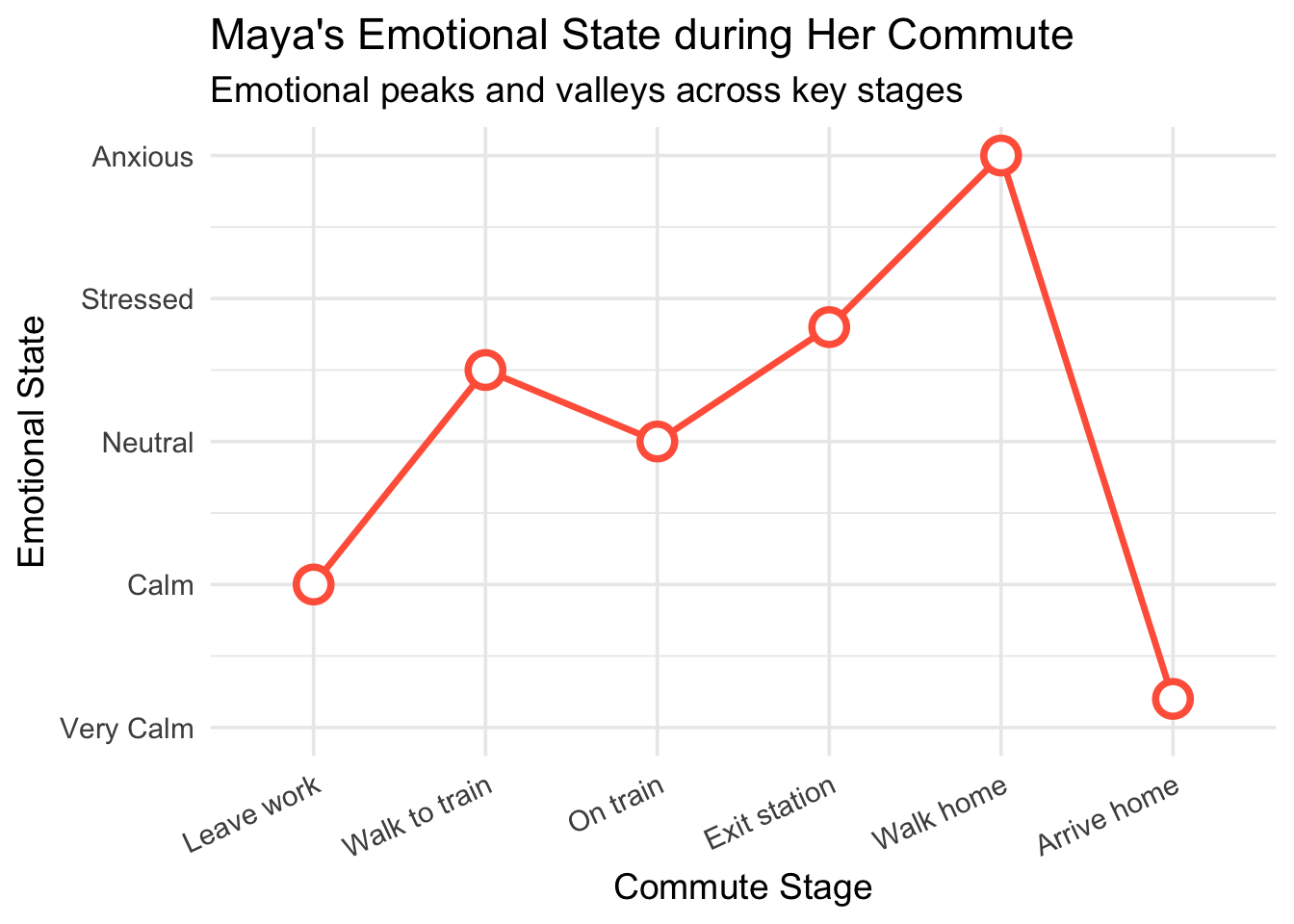
Experience Map — Maya Patel (narrative)
Representative journey map for a professional commuter persona
Following the toolkit naming conventions, this file is named
exp-08.a-experience-map-2025-03-14.qmd.
See also: Grid view of Maya’s commute
Overview
This demo shows how we move from a persona (Maya Patel, 27-year-old accountant in Queens) to an experience map: a stage-by-stage trace of her evening commute.
The map helps us see when Maya’s stress rises, when she finds relief, and how reassurance routines and environmental cues shape her journey.
The goal is not to list every step but to surface emotional peaks and valleys — moments that later become candidate pains for hypothesis generation.
Journey Context
- Persona: Maya Patel
- Goal: Commute home safely and predictably after work or late evening class
- Mode: Subway + 15-minute walk
- Check-in routine: Text roommate when leaving / arriving
Stages of the Commute
1. Leaving the Office / Class
- Doing: Packs bag, checks phone for time, sends quick text (“heading out now”).
- Thinking: “I hope I didn’t stay too late; the streets will be quieter now.”
- Saying: “I’ll text you when I’m on the train.” (to roommate)
- Feeling: Mild apprehension; mentally shifts from work to commute mode.
2. Walking to the Subway
- Doing: Chooses well-lit streets, keeps keys in hand, avoids alleys.
- Thinking: “Better to add 10 minutes than cut through the dark shortcut.”
- Saying: None (headphones in, but no music).
- Feeling: Alert; small spike in anxiety on quieter blocks.
3. Entering the Subway Station
- Doing: Navigates crowds, scans MetroCard/phone pass, heads to platform.
- Thinking: “I should’ve left earlier; rush hour might still be bad.”
- Saying: Brief “excuse me” when passing people.
- Feeling: Heightened vigilance; crowd noise and unpredictability increase stress.
4. In the Subway Car (Crowded Segment)
- Doing: Holds bag close, avoids eye contact, plans exit two stops early.
- Thinking: “What if I can’t get out in time?”
- Saying: None — silence as shield.
- Feeling: Stress spikes; pulse quickens when jostled.
5. Transfer or Delay
- Doing: Reroutes if platform is packed or if train is delayed.
- Thinking: “This will make me late… I hate not knowing how long.”
- Saying: Might mutter frustration (“Not again”).
- Feeling: Frustration + anxiety; uncertainty is more stressful than the delay itself.
6. Neighborhood Walk (Final Stretch)
- Doing: Walks briskly, stays under streetlights, texts roommate with ETA.
- Thinking: “Almost there. Just two more blocks.”
- Saying: Sends text: “5 minutes out.”
- Feeling: Anxiety peaks briefly when street is empty; relief grows as she nears her building.
7. Arrival & Check-In
- Doing: Unlocks apartment door, texts roommate “home safe.”
- Thinking: “Glad that’s over.”
- Saying: “Sorry if I made you worry.”
- Feeling: Relief; stress subsides once inside.
Emotional Peaks & Valleys
- Peak stress: Subway crowding + dark neighborhood blocks.
- Moderate stress: Entering station, reroutes/delays.
- Relief moments: Texting roommate, approaching home, entering apartment.
Surprises & Contradictions
- Social spillover: Roommate shares the burden of vigilance — safety is a shared stress.
- Dual routines: Headphones in (avoid engagement) vs. no music (stay alert).
- Relief ≠ relaxation: “Safe arrival” brings relief but also guilt about making others worry.
Next Steps
- Compare this map with other personas (e.g., Anika Shah) for similarities/differences.
- Highlight emotional spikes as candidate pains.
- Use abduction to generate multiple pain hypotheses from these peaks.
- Retain edge-case clusters (footwear discomfort, social interactions) as possible secondary pains.
Traceability
- From persona: Maya Patel
- From clusters: Reassurance routines, Route choice & environment, Crowding & vigilance, Predictability & control
- Toolkit link: Guide — Experience Mapping